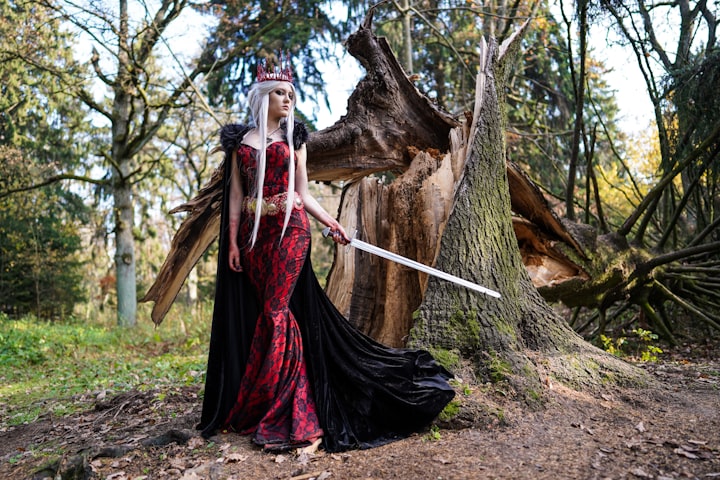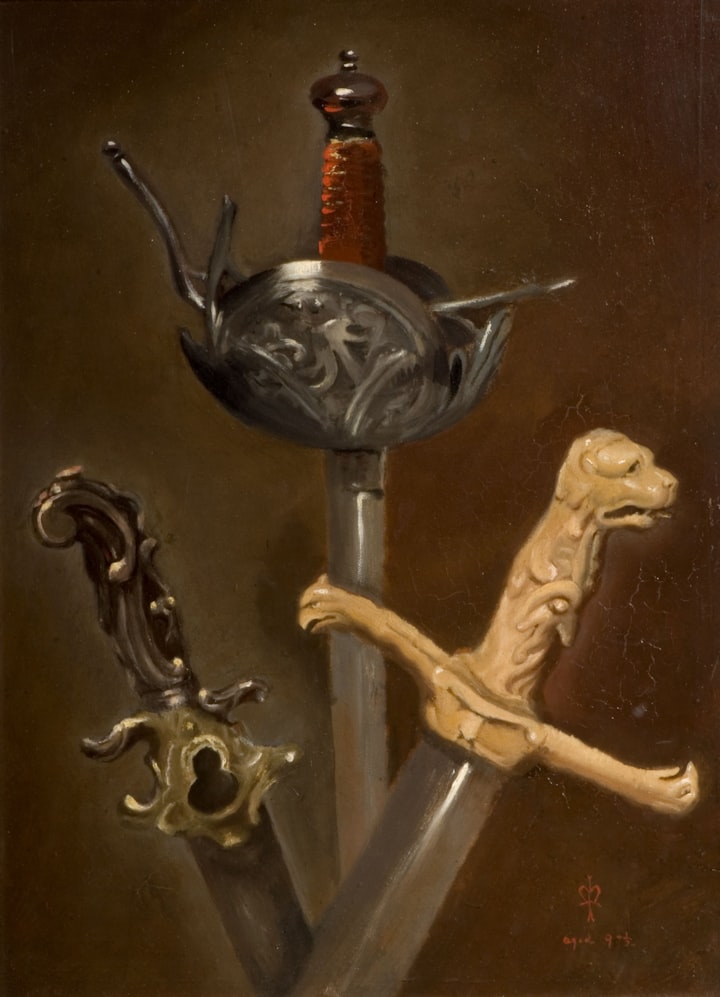Witch-Knights: Warriors of the Lost Gods
A godless arcane paladin variant for 3.0/3.5E D&D.

On the lost world of Arathia, hidden from the rest of the Multiverse, there was a terrible betrayal. One god, the Measurer, grown corrupt and tyrannical, cast his divine kin into an inescapable prison. From this well of infinite silence they could not hear or answer the prayers of their worshipers. Cut off from the gods, the holy warriors of this world could no longer use their priestly powers. The minions of the dark god of stone ruled with an iron fist, grinding away all joy from the lives of the people of Arathia. This was the start of the Grey Times, an era of endless toil, fear, and oppression.
One lone knight, Sir Talanien, set sail chasing a legend, the island of Thune. There it was said were wizards and sorcerers, the Witch-Lords, who knew dark secrets of magic. Barely making it alive across the sea to the mist-shrouded island, Talanien staggered up the shore and collapsed on the beach’s blue sand. Exhausted and starved, he was on the edge of death and his prayers to the Lord of the Dance, the god of seasons and life, went unanswered. Found by a group of young apprentice mages, he was taken to the citadel of the Witch-Lords, a vast tower that grew with each generation of scholars. There, in a hall built of dragon bones, he pleaded his case to the isolated mages and convinced them to help fight against the minions of the evil Measurer.
The high council of the witch-lords conferred. In their isolated domain the forces of oppression had not reached them, few knew they existed and fewer still had the fortitude to journey to their remote island. But after long days of debate it was concluded that they must take action, for they knew they could not abide in silence while the world cried out for help. They formulated a ritual that would use arcane forces to give back some of the help the gods had once given their mortal champions. They knew knights were men and women of action with little time to learn the complexities of magic, but they devised a pact that would bind a knight to the dark reservoirs of power hidden in the fabric of the Multiverse, allowing them to channel invocations through their swords.
No longer able to be quite as idealistic as they had been in happier times, the knights of the fair gods, the Father, the Bride, the Dancer, the Star, and the Deep, accepted the burden of this dark, perilous power in the hope of one day being strong enough to free their holy patrons from imprisonment. In the darkest days these knights sought comfort in darkness itself, so they could be bright beacons of hope to their oppressed peoples.
Exiled from their home world the witch-knights were originally holy warriors, paladins and liberators and others, who were cut off from their gods and had to be trained by a secret society of arcanists to use magic forces in place of divine might to carry on their mission. Since this early origin, the witch-knights have trained others, even paladins who are able to cast divine spells, in their special skills and powers, and so gained allies among those of other faiths. Anywhere the righteous must use arcane power to fight evil, the witch-knight may be found.
Witch-Knight Advancement Table
Level Special Abilities Invocations Known
1 Aura of good, detect evil, bladecraefter, eldritch blade 1d6, invocations
1 (least)
2 Pact grace, dark sacrifice 1
3 Eldritch blade 2d6, aura of courage 1
4 Damage reduction 1/cold iron 2
5 Eldritch blade 3d6 2
6 Special mount 2
7 Eldritch blade 4d6 3 (lesser)
8 Damage reduction 2/cold iron 3
9 Eldritch blade 5d6 3
10 4
11 Eldritch blade 6d6 4
12 Damage reduction 3/cold iron 4
13 Eldritch blade 7d6 5
14 5
15 Eldritch blade 8d6 5
16 Damage reduction 4/cold iron 6
17 Eldritch blade 9d6 6
18 6
19 Eldritch blade 10d6 7
20 Damage reduction 5/cold iron 7
GAME RULE INFORMATION
Witch-knights have the following game statistics.
Abilities: Strength is important for its role in combat, something that all knights must face without fear. Wisdom is needed to maintain their purity when calling on the dark forces of magic and resisting the lures of evil. A score of 14 or higher in Charisma is vital to gain access to the most powerful witch-knight abilities.
Alignment: Fearless and self-sacrificing, witch-knights must be of Good alignment, though few are Lawful.
Hit Dice: 1d10
Class Skills
The witch-knight’s class skills are bluff, climb, concentration, craft (any), diplomacy, intimidate, jump, knowledge (arcane), knowledge (religion), perform, ride, rope use, search, sense motive, swim.
Skill Points at 1st Level: (2 + Int. Modifier) x 4.
Skill Points at Each Additional Level: 2 + Int. Modifier
Class Features
All of the following are class features of the witch-knight.
Weapon & Armour Proficiency: Witch-knights are proficient in all simple and martial weapons, armour, and shields. Because the somatic components required for witch-knights to use invocations are relatively simple, they may use any of their invocations while wearing medium or lighter armour or using medium or smaller shields without incurring the normal arcane spell failure chance. However, like arcane spell casters, a witch-knight wearing heavy armour incurs a chance of spell failure (all invocations, including Eldritch Blade Invocations, have a somatic component). Multiclass witch-knights still incur the normal arcane spell failure chance for arcane spells received from levels in other classes.
Aura of Good: The power of a witch-knight’s aura of good (see the spell detect good) is equal to his class level.
Detect Evil (sp): At will, a witch-knight can detect evil as the spell.
Bladecraefter: All witch-knights learn to make daggers and swords as part of their initial training, and have a base skill rank in Craft (sword-making) equal to their Wisdom modifier + Class Level. Witch-knight squires cannot complete their training until they successfully forge a masterwork sword of unique design that is ready to be turned into an Eldritch Blade. Only swords and knives may be made with this skill, the process requires twice as much time as normal due to the highly ritualistic methods employed, but any such weapon a witch-knight forges may be sold for up to x3 its normal price due to its craftsmanship and beauty.
Witch-knights excel at crafting and repairing blades, and can hone a blade to extreme sharpness. A witch-knight who exceeds the required DC check to forge or repair a blade of any kind by 5 or more points can choose to give it a temporary +1 craftsmanship bonus to either damage or attack rolls. This bonus lasts until the weapon has made a number of successful attacks equal to the witch-knight’s rank in sword-making. This can only be done to a normal weapon, not a magical one.
Eldritch Blade: At 1st level, a witch-knight learns to wield an Eldritch Blade, a masterwork sword of his or her own design and making that allows the witch-knight to channel the forces that empower invocations. Making an Eldritch Blade is one of the final steps in the training of a witch-knight. This weapon is the source of the witch-knight’s power, the soul of the wielder. When the witch-knight has this blade in hand, the damage of the blade can be increased with arcane power in a manner similar to using an Eldritch Blast modified by the Hideous Blow blast shape invocation. Unlike using an Eldritch Blast attack, this requires an actual melee strike, but eldritch energies increase the damage of every successful attack made with an Eldritch Blade by its owner. The witch-knight must have this weapon in hand as a focus to use any invocations known in much the way a cleric must use a holy symbol to cast spells. Only the maker of a given Eldritch Blade can use it in this manner. To any other wielder, even another witch-knight, it is just a masterwork weapon of unusual design, though other members of this class know at a glance what type of weapon it is and who owns it.
Eldritch blades can be made in the form of any sword the maker is proficient in. A witch-knight can only be attuned to a single weapon at a time, but may have replacement swords in case their current blade is destroyed. A substitute blade must be attuned to its wielder through a day-long ritual before it can be used to channel magical energy or else it is just a masterwork sword.
Invocations: Starting at 1st level, a witch-knight begins learning magical invocations like those used by Warlocks. Due to their martial training, witch-knights only have the capacity to learn Least and Lesser Invocations, and they do not learn as many as a warlock would. Unlike a warlock, who needs no focus or material component to call forth an invocation, a witch-knight must hold an attuned Eldritch Blade as a focus in order to use any known invocations. The somatic components of a witch-knight’s invocations are elaborate flourishes made with their swords. Witch-knights do not learn blast shape invocations as their Eldritch Blade power replaces the Eldritch Blast of the warlock, but may learn any other invocations allowed by their level. Any Eldritch Essence Invocations used alter the effect of the knight’s Eldritch Blade.
Pact Grace (su): At 2nd level, a witch-knight gains an eldritch bonus equal to his or her Charisma bonus (if any) on all saving throws.
Dark Sacrifice (su): At 2nd level, a witch-knight learns to heal others by giving up life energy in lieu of divine assistance. The witch-knight can Lay on Hands as a paladin of equal level, but each time the witch-knight uses this power, a Fortitude save must be made. Failure means the witch-knight loses as many hp as the subject of the healing gained, success means no damage is suffered. No arcane power can restore these lost hit points; they can only be restored through natural or divine healing.
Aura of Courage (su): Beginning at 3rd level, the witch-knight gains immunity to all fear effects. Allies within 10’ feet of the knight gain a +4 morale bonus on saving throws against fear effects. This ability functions while the witch-knight is conscious, not unconscious or dead.
Damage Resistance (su): Fortified by supernatural power, a witch-knight becomes resistant to physical attacks at 4th level, gaining damage resistance 1/cold iron. At 8th level and every four levels thereafter, a witch-knight’s damage reduction improves as shown on the Witch-knight Advancement Table.
Special Mount (Sp): Upon reaching 6th level, a witch-knight gains the service of an unusually intelligent, strong, and loyal steed to serve her in her crusade against evil. This mount is usually a heavy warhorse (for a Medium witch-knight) or a war pony (for a Small witch-knight).
Once per day, as a full-round action, a witch-knight may magically call her mount from the celestial realms in which it resides. This ability is the equivalent of a spell of a level equal to one-third the witch-knight’s level. The mount immediately appears adjacent to the witch-knight and remains for 2 hours per witch-knight level; it may be dismissed at any time as a free action. The mount is the same creature each time it is summoned, though the witch-knight may release a particular mount from service.
Each time the mount is called, it appears in full health, regardless of any damage it may have taken previously. The mount also appears wearing or carrying any gear it had when it was last dismissed. Calling a mount is a conjuration (calling) effect.
Should the witch-knight’s mount die, it immediately disappears, leaving behind any equipment it was carrying. The witch-knight may not summon another mount for thirty days or until she gains a witch-knight level, whichever comes first, even if the mount is somehow returned from the dead. During this thirty-day period, the witch-knight takes a -1 penalty on attack and weapon damage rolls.
Code of Conduct: Witch-knights must be of good alignment and lose all class abilities if they ever willingly commit evil acts.
Associates: While a witch-knight may adventure with characters of good or neutral alignment, the witch-knight will never knowingly associate with evil characters, nor will any association who consistently offends the witch-knight’s moral code be continued. A witch-knight may not accept henchmen, followers, or cohorts who are evil.
Ex-Witch-Knights
A witch-knight who willingly commits an evil act, or who grossly breaches the code of conduct, loses all invocations and other class abilities (but not weapon, armour, and shield proficiencies). The witch-knight may not progress any further in levels in this class. All class abilities and advancement potential may be regained if the violations are atoned for (see the atonement spell description), as appropriate.
Like any member of any other class, a witch-knight may be a multiclass character, but multiclass witch-knights face a special restriction. A witch-knight who gains a level in any other class may never again rise in witch-knight level, though all witch-knight abilities are retained.
About the Creator
Samuel Wright
I am a writer & tarot reader in Oregon. I'm a TTRPG fan, love all types of sci-fi & fantasy books, movies, & games, & read voraciously. I write a variety of content, mostly RPG blogs. Tell me where you found my page.
Art by Google/Unsplash






Comments
There are no comments for this story
Be the first to respond and start the conversation.